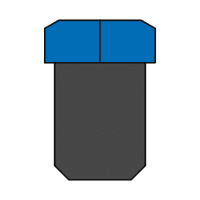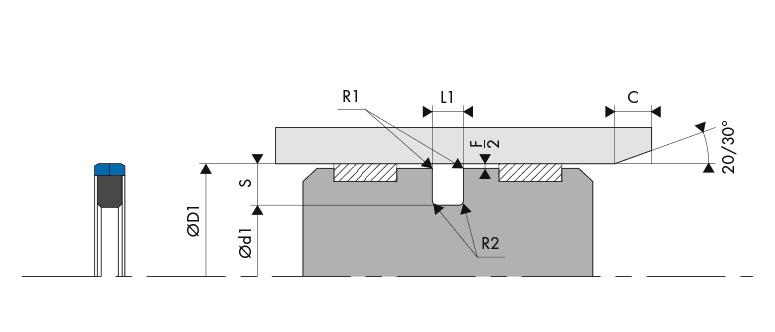BECA 655



Description
The BECA 655 profile is a double acting composite piston seal composed of a profiled rubber ring and a polyamide or POM friction ring with a step cut.
Advantages
The square ring does not twist
Low friction coefficient
Excellent extrusion resistance
Compatible with hydraulic oils
Technical data
| Temperature | -30°C/+100°C |
|---|---|
| Pressure | 50 MPa |
| Speed | 0.5 m/s |
| Medias | Mineral hydraulic oils |
Applications
Agriculture
Mobile machinery
Hydraulic cylinders
Materials
Friction ring
Polyamide PA6
Polyoxymethylene (POM)
Profiled seal
NBR 70 Shore A
Dimensions

Installation dimensions

Installation dimensions
| Groove diameter | Groove width | Radial section |
|---|---|---|
| Ød1 h9 | L1 0/+0.20 | S |
| D1 - 11.00 | 4.20 | 5.50 |
| D1 - 15.50 | 6.30 | 7.75 |
| D1 - 21.00 | 8.10 | 10.50 |
For special applications > 40 MPa, we recommend using an H8/f8 tolerance (bore/piston) or selecting other more suitable materials. Please contact our experts.
Materials
Polyamide - PA6G
There are different types of polyamides, more commonly known as "nylons". The most important are: PA 6, PA 66, PA 11 and PA 12. These types of nylons have different physical properties, mainly their composition and the structure of their molecular chains.
The PA6G polyamide is characterised by its stiffness, strong sliding abilities, excellent machinability and excellent resistance to wear and abrasion.
| Advantages | Good mechanical resistance, stiffness, hardness and resilience Good fatigue resistance Strong shock absorbing potential Good sliding properties Excellent wear resistance Good electrical insulation properties Good resistance to high-energy radiation Good machinability |
|---|---|
| Limits | Dimensional stability is not as good as POM |
| Temperature range | -30°C / +120°C (very short term peak at 180°C) |
Polyoxymethylene - POM
Polyoxymethylene (POM or polyacetal) belongs to the thermoplastics, which have a number of advantages - strong mechanical resistance, good creep strength, high resistance to shocks, particularly at low temperatures, good wear resistance, good sliding coefficient, excellent machinability and good dielectric properties. The low water absorption coefficient, unlike polyamide (PA), also gives this material an excellent dimensional stability.
| Chemical resistance |
Aliphatic hydrocarbons (propane, butane, petroleum, diesel fuel) |
|---|---|
| Compatibility issue | Acids |
| Temperature range | -50°C/+115°C |
NBR
Nitrile rubber (NBR) is the general term for acrylonitrile-butadiene copolymer. The ACN content can vary between 18% and 50%. While the acrylonitrile content is important, the resistance to oil and fuel is more so. Conversely, the elasticity and compression set are not as good. The NBR has good mechanical properties and good wear resistance. However, its resistance to atmospheric agents and the ozone is relatively low.
| Chemical resistance | Aliphatic hydrocarbons (propane, butane, petroleum, diesel fuel) Mineral oils and greases Fire-resistant fluids (HFA, HFB and HFC) Diluted acids, low-temperature alkaline and saline solutions Water (up to +100°C max) |
|---|---|
| Compatibility issue | Fuels with high aromatic content Aromatic hydrocarbons (benzene) Chlorinated hydrocarbons (trichlorethylene) Polar solvents (ketone, acetone, acetic acid, ethylene-ester) Strong acids Glycol-based brake fluids Atmospheric and ozone agents |
| Temperature range | -30°C/+100°C -40°C / +100°C with our low-temperature NBR |
Technical data

Extrusion gaps
| Pressure MPa |
Radial extrusion gap F/2 |
|---|---|
| 20 MPa | 0.25 |
| 35 MPa | 0.20 |
| 40 MPa | 0.15 |
| 50 MPa | 0.10 |
Surface roughness
| Roughness | Dynamic surface area | Static surface area | Groove flanks |
|---|---|---|---|
| Ra | 0.05 - 0.2 µm | ≤ 1.6 µm | ≤ 3.2 µm |
| Rz | 0.4 - 1.6 µm | ≤ 6.3 µm | ≤ 10.0 µm |
| Rmax | 0.63 - 2.5 µm | ≤ 10.0 µm | ≤ 16.0 µm |
Chamfers and radius
| Radial section S |
Radius R1 |
Radius R2 |
Chamfer C |
|---|---|---|---|
| 5.50 | 0.30 | 0.50 | 3.00 |
| 7.75 | 0.30 | 0.90 | 4.00 |
| 10.50 | 0.30 | 0.90 | 5.00 |
|
655.070HCK6
|
70,00 | 49,00 | 8,10 |
|
655.075HCK6
|
75,00 | 54,00 | 8,10 |
|
655.080HCK6
|
80,00 | 59,00 | 8,10 |
|
655.085HCK6
|
85,00 | 64,00 | 8,10 |
|
655.090HCK6
|
90,00 | 69,00 | 8,10 |
|
655.095HCK6
|
95,00 | 74,00 | 8,10 |
|
655.100HCK6
|
100,00 | 79,00 | 8,10 |
|
655.105HCK6
|
105,00 | 84,00 | 8,10 |
|
655.110HCK6
|
110,00 | 89,00 | 8,10 |
|
655.115HCK6
|
115,00 | 94,00 | 8,10 |
|
655.120HCK6
|
120,00 | 99,00 | 8,10 |
|
655.125HCK6
|
125,00 | 104,00 | 8,10 |
|
655.130HCK6
|
130,00 | 109,00 | 8,10 |
|
655.140HCK6
|
140,00 | 119,00 | 8,10 |
|
655.150HCK6
|
150,00 | 129,00 | 8,10 |
|
655.160HCK6
|
160,00 | 139,00 | 8,10 |
|
655.170HCK6
|
170,00 | 149,00 | 8,10 |
|
655.180HCK6
|
180,00 | 159,00 | 8,10 |
|
655.190HCK6
|
190,00 | 169,00 | 8,10 |
